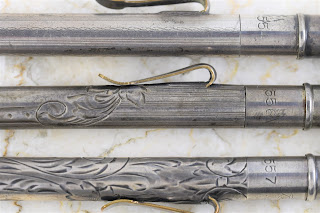This article has been edited and included in The Leadhead's Pencil Blog Volume 5; copies are available print on demand through Amazon here, and I offer an ebook version in pdf format at the Legendary Lead Company here.
If you don't want the book but you enjoy this article, please consider supporting the Blog project here.
What had me excited was that it is a Sheaffer “Skyboy,” a name reserved by Sheaffer in 1941-1942 for its top-of-the-line model, supposedly (with respect to the pens anyway) better able to withstand the rigors of flight:
These don’t turn up that often, so whenever I have the chance to pick up another one I jump at the chance. I’ve even jumped on the pens: here’s a grey one I acquired at the DC Show a few years back – pity the set is missing the pencil, since I’ve not seen a gray one:
“The Airplane Special - Writes in Flight,” according to the paperwork that came with my pen. Note that my pen has the rigid radius clip, while my pencil has the over-the-top military style clip. Since I didn’t have one in black, I was so excited at the opportunity that I didn’t care that it didn’t have a tip . . . with all the parts I’ve got laying around, I was sure I could replace it.
But then the pencil arrived, and on closer examination, something isn’t quite right about this one . . .
It doesn’t need a tip to function. Unlike every other Sheaffer I’ve encountered, this one has a lower barrel threaded on the inside, which screws onto a very different mechanism. The end of the mechanism, unlike every other Sheaffer I’ve encountered, is actually shaped at the end to hold the lead securely in place. On every other Sheaffer I’ve seen, it is the metal tip which performs that function.
If this seems like an obscure and trivial difference, here’s a shot of this new example alongside my other military clip examples to show you just how different this one is:
The caps are all identical in length and diameter, but the entire nose end of this black example is unlike any other Sheaffer pencil I’ve seen:
It does have the same “400" imprint on the reverse of the barrel, denoting a price of $4.00:
When disassembled and shown alongside it’s “normal” cousin, you can see how just a couple minor tweaks under the hood made such a tremendous different in the outward appearance:
The only difference is a small blue bushing added to make the mechanism fit in a more confined space, and the end of the mechanism has been modified to fit snugly around the lead.
The blue bushing is a bit deformed, since the barrel has to be screwed down tightly enough that advancing the lead doesn’t inadvertently unscrew the entire lower barrel. It’s an ingenious way to conserve metal by eliminating that large, solid metal tip, when metals were tightly rationed at the beginning of the Second World War.
Apparently any panic over a need to eliminate unnecessary metal parts subsided quickly after Sheaffer secured military contracts to make bomb sights. I’ve never seen another pencil like this one - even though it is such an elegant solution which must have decreased the cost of manufacture, in addition to providing an even more streamlined look to match the company’s Balance line of pens. It certainly adds a bit of pizzazz to a corner at the museum, too.









































































